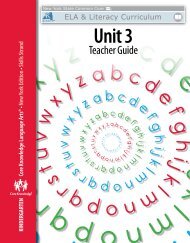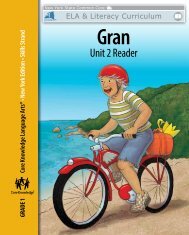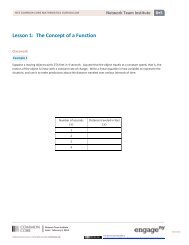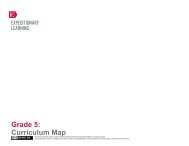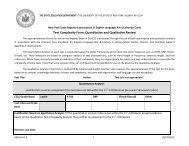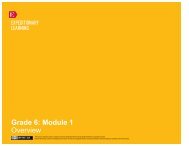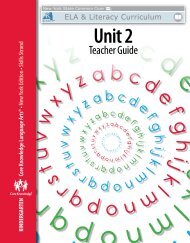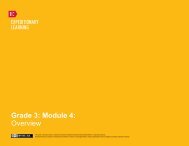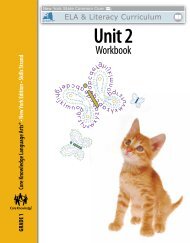Grade 4 ELA Module 1, Unit 3, Lesson 3 - EngageNY
Grade 4 ELA Module 1, Unit 3, Lesson 3 - EngageNY
Grade 4 ELA Module 1, Unit 3, Lesson 3 - EngageNY
You also want an ePaper? Increase the reach of your titles
YUMPU automatically turns print PDFs into web optimized ePapers that Google loves.
<strong>Grade</strong> 4: <strong>Module</strong> 1: <strong>Unit</strong> 3: <strong>Lesson</strong> 3<br />
Close Read:<br />
Communication and Conflict Resolution Strategies<br />
This work is licensed under a Creative Commons Attribution-NonCommercial-ShareAlike 3.0 Unported License.<br />
Exempt third-party content is indicated by the footer: © (name of copyright holder). Used by permission and not subject to Creative Commons license.
GRADE 4: MODULE 1: UNIT 3: LESSON 3<br />
Close Read:<br />
Communication and Conflict Resolution Strategies<br />
Long-Term Targets Addressed (Based on NYSP12 <strong>ELA</strong> CCLS)<br />
I can answer questions using evidence from text. (RI.4.1)<br />
I can determine the main idea using specific details from the text. (RI.4.2)<br />
Supporting Learning Targets<br />
• I can identify details from the article “Smart-Speak” to support my answers to questions.<br />
• I can group details from the article to identify the main idea.<br />
Ongoing Assessment<br />
• Teacher observations<br />
• Close read annotations and margin notes<br />
Copyright © 2013 by Expeditionary Learning, New York, NY. All Rights Reserved. NYS Common Core <strong>ELA</strong> Curriculum • G4:M1:U3:L3 • June 2013 • 1
GRADE 4: MODULE 1: UNIT 3: LESSON 3<br />
Close Read:<br />
Communication and Conflict Resolution Strategies<br />
Agenda<br />
1. Opening<br />
A. Engaging the Reader (5 minutes)<br />
2. Work Time<br />
A. Reviewing Close Reading (15 minutes)<br />
B. Close Reading of “Smart-Speak” (30 minutes)<br />
3. Closing and Assessment<br />
A. Debrief (5 minutes)<br />
B. Exit Ticket (5 minutes)<br />
4. Homework<br />
Teaching Notes<br />
• Preview the article “Smart-Speak” by Marilyn Cram Donahue<br />
• Review: Helping Students Read Closely (Appendix 1)<br />
• Review the Possible Rules to Strengthen Our School Community model. This will guide you when the<br />
students suggest rules after reading the article.<br />
<strong>Lesson</strong> Vocabulary<br />
main idea, supporting details, gist,<br />
solution(s), conflict resolution, resolve,<br />
scowled, specialist, unproductive,<br />
encouraging, body language, jiggle,<br />
tug, snapped (verb), dialogue<br />
Materials<br />
• Close Readers Do These Things anchor chart (from <strong>Unit</strong> 1)<br />
• “Smart-Speak” by Marilyn Cram Donahue (one per student)<br />
• Possible Rules to Strengthen Our School Community anchor chart (prepared by teacher between <strong>Lesson</strong>s 1 and 2, based on<br />
students’ analysis of school survey data)<br />
• Possible Rules to Strengthen Our School Community model<br />
• Index cards (one per student)<br />
Copyright © 2013 by Expeditionary Learning, New York, NY. All Rights Reserved. NYS Common Core <strong>ELA</strong> Curriculum • G4:M1:U3:L3 • June 2013 • 2
GRADE 4: MODULE 1: UNIT 3: LESSON 3<br />
Close Read:<br />
Communication and Conflict Resolution Strategies<br />
Opening<br />
A. Engaging the Reader (5 minutes)<br />
• Invite the class to read the first learning target aloud with you: “I can identify details from the article to support my answers<br />
to questions.”<br />
• Circle the phrase support my answers. Ask the students to define support in this context. How would they support their<br />
answers to questions? Listen for comments such as: “I can back up my answer with information from what I read,” or “I can<br />
find the answer in the book or find a sentence in the book that proves my answer is right.”<br />
• Remind the students of their work so far in <strong>Unit</strong>s 1 and 2 with identifying the main idea and how details support the main<br />
idea. Ask the students: “How do you determine the main idea in a text? What are supporting details?” Invite students to<br />
think, then share with a partner, about these questions. Ask: “How does determining the main idea and explaining how it is<br />
supported with details help us as readers?” Invite students to think, then share with a partner, about this question.<br />
• Tell students that today they will be practicing these reading skills with peers when reading the article “Smart-Speak.”<br />
Explain that this article shares rules for solving conflicts in a peaceful way that are similar to rules the Iroquois created.<br />
Suggest to the class that these strategies might help create rules for conflict resolution just as it did for the Iroquois, which<br />
might make school a nicer place.<br />
Meeting Students’ Needs<br />
• Use thoughtful grouping: Consider<br />
partnering an ELL with a student<br />
who speaks the same L1 when<br />
discussion of complex content is<br />
required. This can allow students to<br />
have more meaningful discussions<br />
and clarify points in their L1.<br />
Copyright © 2013 by Expeditionary Learning, New York, NY. All Rights Reserved. NYS Common Core <strong>ELA</strong> Curriculum • G4:M1:U3:L3 • June 2013 • 3
GRADE 4: MODULE 1: UNIT 3: LESSON 3<br />
Close Read:<br />
Communication and Conflict Resolution Strategies<br />
Work Time<br />
A. Reviewing Close Reading (15 minutes)<br />
• Remind the students of the close reading they did of the Great Law of Peace (Iroquois Constitution) in <strong>Unit</strong> 1, and of sections<br />
of Eagle Song during <strong>Unit</strong> 2. Explain to students that they will be close reading a new article today in order to better<br />
understand how to solve problems in school.<br />
• Ask students to find a partner. With this person, they should discuss their process of reading the Great Law of Peace closely.<br />
Distribute index cards. Advise the class: “Be sure to explain what you did first, next, and any strategies you used while<br />
reading. Once you and your partner have shared, write down on the index card the skills you used as close readers.” Give the<br />
students 10 minutes to discuss how to close read and record the steps on their index cards.<br />
• When the students have finished their discussions, invite students to share the things they did yesterday when they read<br />
closely.<br />
• After the students share ideas, check that all the steps were discussed by re-orienting students to the Close Readers Do<br />
These Things anchor chart they created in <strong>Unit</strong> 1.<br />
Note: This is not a rigid set of steps; at this point students may be realizing that different texts require slightly different<br />
approaches, and that close readers can use many strategies. But be sure that students basically describe the following<br />
process:<br />
• Read aloud if the text is really hard.<br />
• Read the whole thing slowly and think about the central message or main idea.<br />
• Reread passages one chunk at a time.<br />
• Underline things that you know about.<br />
• Circle words that you do not know.<br />
• Try to figure out words from the context.<br />
• Talk about what you understand and what you don’t.<br />
• State the gist or message of the paragraph in the margin.<br />
• Reread a third time in order to find answers to questions and revise and record.<br />
Meeting Students’ Needs<br />
• For ELLs, consider posting<br />
nonlinguistic symbols for some of<br />
the key vocabulary terms in the<br />
targets.<br />
• For fluent readers, focus on context<br />
clues.<br />
• For students still developing reading<br />
fluency, focus on word attack<br />
strategies, and then move to context<br />
clues, if needed.<br />
• Consider writing and displaying<br />
steps for multistep directions. ELLs<br />
can return to steps to make sure<br />
they are on track.<br />
Copyright © 2013 by Expeditionary Learning, New York, NY. All Rights Reserved. NYS Common Core <strong>ELA</strong> Curriculum • G4:M1:U3:L3 • June 2013 • 4
GRADE 4: MODULE 1: UNIT 3: LESSON 3<br />
Close Read:<br />
Communication and Conflict Resolution Strategies<br />
Work Time (continued)<br />
B. Close Reading of “Smart-Speak” (30 minutes)<br />
• As you distribute the article to students, tell them that now they will work together, with your help, to try reading closely the<br />
article “Smart-Speak” by Marilyn Cram Donahue.<br />
• Ask the class to read the article silently. Ask students for a thumbs-up if they have something to say about the article. Say:<br />
“Good start! Let’s see if we can learn more!”<br />
• For the second read, chunk the article into smaller sections. Ask students to chorally reread the section “What Are You<br />
Afraid Of?” Ask students to underline anything they know from their previous learning and/or think they understand. Ask<br />
them to turn to a partner and say what they think the section says.<br />
• Students should each individually write down the gist of the section in their own words. They should write it as a short<br />
phrase in the margin. An example might be: “Saying how we feel can be scary sometimes, but it’s important to be honest.”<br />
• Say: “We are going to read this section a third time. Let’s see if we can figure out what some new words mean. To do this, we<br />
will ask clarifying questions and then try to look in the text to help us figure out the answers. Just as I showed you earlier.”<br />
• Model again briefly how to focus on vocabulary during this third read. Draw students’ attention to the word excuses. Ask:<br />
“What does this word mean?” Invite students to tell their partners what they think it means.<br />
• Invite students to continue their third read with a partner. Students should take turns telling the partner what they<br />
understand, asking clarifying questions, and then working together to return to the text to try to find answers.<br />
• Point out to students that today, they were not asked to answer any specific questions about the text. They have been<br />
building their skills as close readers for about six weeks, and today you wanted to just let them try to get all the meaning they<br />
could on their own.<br />
• Then ask students to revisit and revise their gist statement.<br />
• Ask the partnered students to keep working together on each remaining chunk of the article. They should continue<br />
practicing the close reading process, asking clarifying questions, focusing on key vocabulary, and referring back to the text<br />
with their partner to check that they understand the main ideas.<br />
• Monitor students and support their reading of this article as needed. Consider working with a small group if some students<br />
need more support.<br />
Meeting Students’ Needs<br />
• For enrichment, group above-gradelevel<br />
students together during<br />
Session 2 and invite them to<br />
summarize which survey group<br />
appears to be treated most unfairly<br />
and predict why that might be.<br />
Copyright © 2013 by Expeditionary Learning, New York, NY. All Rights Reserved. NYS Common Core <strong>ELA</strong> Curriculum • G4:M1:U3:L3 • June 2013 • 5
GRADE 4: MODULE 1: UNIT 3: LESSON 3<br />
Close Read:<br />
Communication and Conflict Resolution Strategies<br />
Closing and Assessment<br />
A. Debrief (5 minutes)<br />
• After the students have finished reading the article, invite them to gather whole group. Display the Possible Rules to<br />
Strengthen Our School Community anchor chart (created by teacher between <strong>Lesson</strong>s 1 and 2)<br />
• Ask: “What are some rules from Smart-Speak?” Invite several students to share rules for conflict resolution. List the rules on<br />
the anchor chart (see the Possible Rules to Strengthen Our School Community model for suggestions). Ask<br />
students if the rules they have read so far have are similar to the rules the Iroquois created. In what ways?<br />
• Debrief the close reading experience. Ask students to turn and talk to a partner to answer the following question: “What<br />
parts of today’s lesson helped you learn from your reading?” After they have talked in pairs, share out and celebrate students’<br />
great reading.<br />
• Remind students that tomorrow, they will be taking the Mid-<strong>Unit</strong> 3 Assessment. They will be reading a new text on their<br />
own, and practicing close reading. Address any questions students have about close reading.<br />
Meeting Students’ Needs<br />
• Provide ELLs with a sentence<br />
starter to aid in language<br />
production. For example: One rule<br />
from the article is _______.<br />
B. Exit Ticket (5 minutes)<br />
• Hand each class member an index card and ask them to reread the Listening to Both Sides box at the end of “Smart-<br />
Speak.” Ask the students to rewrite each of the negative “You” statements as positive “I” statements.<br />
• Provide students with enough time to rewrite the statements.<br />
• Glance over them for a quick assessment and to help with planning for the next lesson’s learning needs.<br />
Homework<br />
Meeting Students’ Needs<br />
• For tonight’s homework, continue reading at your independent level at home.<br />
Note: The students will be taking the mid-unit assessment tomorrow (answering text-dependent questions, including those<br />
about main idea).<br />
Copyright © 2013 by Expeditionary Learning, New York, NY. All Rights Reserved. NYS Common Core <strong>ELA</strong> Curriculum • G4:M1:U3:L3 • June 2013 • 6
<strong>Grade</strong> 4: <strong>Module</strong> 1: <strong>Unit</strong> 3: <strong>Lesson</strong> 3<br />
Supporting Materials<br />
This work is licensed under a Creative Commons Attribution-NonCommercial-ShareAlike 3.0 Unported License.<br />
Exempt third-party content is indicated by the footer: © (name of copyright holder). Used by permission and not subject to Creative Commons license.
GRADE 4: MODULE 1: UNIT 3: LESSON 3<br />
Close Read:<br />
Communication and Conflict Resolution Strategies<br />
“Smart-Speak” by Marilyn Cram Donahue<br />
From Weekly<br />
Reader, December<br />
2003. Copyright ©<br />
2003 by The<br />
Weekly Reader<br />
Corporation.<br />
Reprinted by<br />
permission of<br />
Scholastic Inc.<br />
Copyright © 2003 The Weekly Reader Corporation. Used by permission and<br />
not subject to Creative Commons license. NYS Common Core <strong>ELA</strong> Curriculum • G4:M1:U3:L3 • June 2013 • 8
GRADE 4: MODULE 1: UNIT 3: LESSON 3<br />
Close Read:<br />
Communication and Conflict Resolution Strategies<br />
Possible Rules to Strengthen Our School Community Model<br />
(for Teacher Reference)<br />
1. Think about what you want to say first<br />
2. Speak with a calm voice and make eye contact<br />
3. Use “I” statements to say how you feel<br />
4. Listen to what the other person has to say<br />
5. When you are angry or upset, count to 10 then speak again<br />
6. If you can’t solve your problems together, ask another person to help<br />
Copyright © 2013 by Expeditionary Learning, New York, NY. All Rights Reserved. NYS Common Core <strong>ELA</strong> Curriculum • G4:M1:U3:L3 • June 2013 • 9



